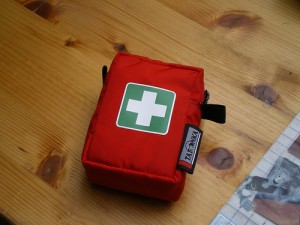Create a First Aid Kit for Camping

Photo by marvinxsteadfast
Most camping trips include some kind of minor injury. This may be a scratch, burn, sting, or some form of bump or bruise. Occasionally the injury is more severe like a sprain or broken bone. Most campgrounds may have some type of first aid station, but it is not always necessary, or practical to make the trek if the injury is small. Anyone can treat minor injuries with some basic supplies. Make up a camping first aid kit for your next camping trip and be prepared. This is what you will need:
-
Adhesive tape can be used to hold gauze in place. It can be used to hold cuts together until stitches can be put in, and it can be used with other materials to form splints for possible broken bones.
-
Band-Aids can be used to cover cuts, scrapes, puncture wounds and blisters. A box of assorted sizes should be purchased.
-
Gauze rolls may be used to control bleeding and cover wounds.
-
Gauze pads may be used to clean wounds, control bleeding and cover wounds. The most common size to include is 4” X 4”. Be sure to purchase individually rapped gauze pads to keep them clean and sterile.
-
Elastic bandages can be used to wrap suspected sprains to keep swelling down. They may also be used to make splints.
-
Bandage scissors or shears can be used to cut the injured persons cloths, or bandages, tape or gauze.
-
Triangular bandages can be used for slings and tourniquets.
-
Tweezers can be used to remove a variety of foreign bodies like ticks, splinters, stingers and dirt and gravel from wounds.
-
Hydrogen peroxide can be used to clean wounds and for a mouth wash as long as it is not swallowed.
-
Calamine lotion can be used for sunburns, insect bites, and poison ivy.
-
Ipecac syrup is used to induce vomiting. This is especially necessary when camping with small children.
-
Rubbing alcohol can be used to sterilize tweezers and needles and to clean minor wounds.
-
Pain relievers such as Advil, Tylenol or equivalent generic brands. Make sure to include products suitable for children and adults.
-
Topical ointments such as Bacitracin or Neosporin to prevent infection of scrapes and scrapes.
-
Benadryl for allergies and bee stings-capsules for adults, liquid for children. Be sure to check expiration dates on this and all other medications.
There are other items you may include such as a basic first aid manual, waterproof matches, safety pins, antacids, nail clippers, hot and cold packs and even a cell phone to call 911. Prescription medication can be kept for those that need it and snake bite kits and or Epi-Pens should be included if necessary. All of the items should be stored in a waterproof container. A plastic toolbox or tackle box is ideal.
If the injury is more severe like a broken bone, a bad burn, or a deep cut that may require stitches head for the first aid station or nearest medical treatment after administering necessary first aid such as immobilizing the arm or leg, or cleaning and covering any open wounds after any bleeding has been stopped.Any bites from wild animals also require prompt medical attention to evaluate the risk of exposure to rabies.


Great Post! Glad you understand the need for Elastic Bandages when providing first aid. It is also important to make sure the medical supplies are good quality and able to be purchased at wholesale prices. Keep up the good work guys!
Comment by Joe Giovinco — December 22, 2009 @ 11:33 pm
Good post, except that snakebite kits are generally not recommended anymore. The old “cut a cross over the bite and suck out the poison” thing is no longer done, so the commercially produced snakebite kits are pointless. They can actually do more harm than good. I like to include a small magnifying glass (like a jeweler’s loupe) to make tick, splinter and stinger removal easier. And if you’re camping/hiking alone, a small mirror is useful for locating ticks on parts of the body you can’t see! A needle, duct tape, moleskin, and hand sanitizer come in handy, too. (And hand sanitizer makes a very dependable emergency fire starter because it’s primarily alcohol.)
Comment by Ratty — September 5, 2010 @ 8:03 pm